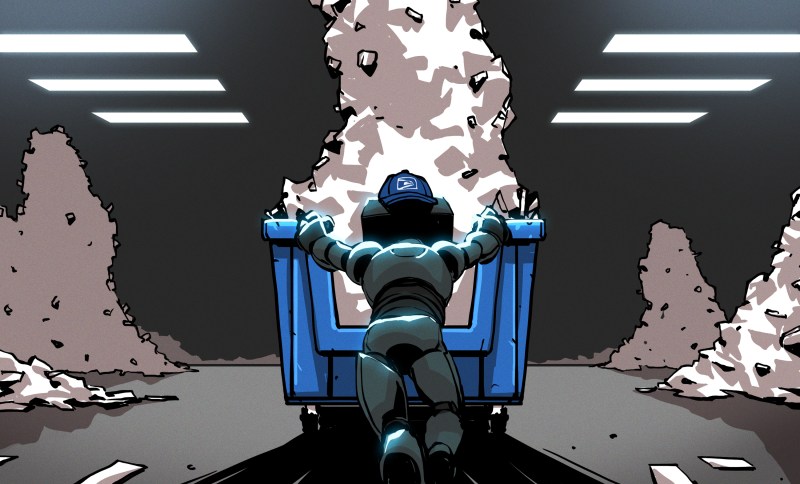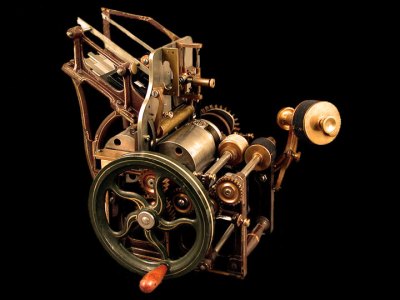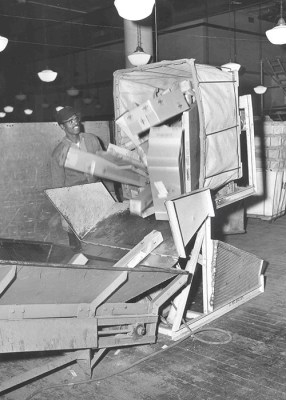
When we last left this subject, I told you all about Transorma, the first letter-sorting machine in semi-wide use. But before and since Transorma, machines have come about to perform various tasks on jumbled messes of mail — things like distinguishing letters from packages, making sure letters are all facing the same way before cancelling the postage, and the gargantuan task of getting huge piles of mail into the machines in the first place. So let’s dive right in, shall we?
The Canceller

It didn’t take too long for hand-canceling to get out of hand. The first cancelling machine, created in 1875, made fairly quick work of that.
The thing was hand-fed, hand-cranked, and only worked on items of a single size and shape. Still, this machine created by Thomas and Martin Leavitt laid the way for all future cancelling machines.
Once the letters were inserted, a number of feed rollers separated the pieces and fed them into the machine singly and spaced apart.
The letter would then move on to a rotating die hub and ring die that did the actual cancelling, adding the postmark and those iconic wavy lines of cancellation. Finally, the mail piece passed to a stacking bin for retrieval.
The Culling Machine
Although the cancelling machine saved a great deal of time and labor over hand-canceling everything, there was still plenty of room for improvement. The culling machine’s job is to separate mail based on size before it gets canceled. Not only did the culling machine save time and space, it made for more sanitary working conditions.
The machine works like a sieve, or one of those sorters where coins fall through the holes based on size — the smaller items dropped to the bottom. The idea was to sort large, flat envelopes and packages from regular letters and then pass them on to other machinery.
At some point, a study was done on culling machines which found that they weren’t very economical or efficient. Even though they saved some money, the speed of mechanical culling was about the same as manual culling. But in 1960, someone designed a culling machine with several inclined belts and horizontal cylinders that would remove oversize pieces. This machine could cull about 60,000 pieces of mail per hour.
Be sure to check out the video below, which tells all about automatic culling and cancelling of letters.
The Edger-Stacker
Improvements in pre-cancellation continued throughout the postal system. Once mail was culled, it had to be stacked in one direction in order to go through the canceling machine, and this was largely still done by hand. But some enterprising postal employees in the Nashville, TN post office dreamed up a machine that would do this mechanically.
No longer would letters have to be hand-stacked before entering the cancelling machine. USPS was chuffed about this invention since it had been thought up by postal employees. But it was also quite successful, showing an ROI ranging from 70% at one post office to 566% at another.
The Facer-Canceller
Perhaps the most important part of organizing anything tangible is to get all the pieces going the same direction, like a game of 52-card pickup. Thus the facing part of the facer-canceller is quite important. Now, letters could be fed in every which way and would in theory get flip-turned upside down if necessary in order to be cancelled.

Developed in 1958, the first facer-cancellers worked using light sensors to detect the stamp’s location and flip the letter if necessary to face the stamp for proper cancellation. It also used optical sensors to detect the color contrast between stamp and envelope, but it didn’t always work — insufficient contrast would fool the device.
The next phase in facing technology was the use of invisible-to-the-eye phosphorescent inks in the stamps themselves, rather than relying on contrast. This improved machine could only process about 3,000 more letters per hour, but the rejection rate went way down.
Even so, up to 500 letters could be cancelled per minute. Whereas letters were previously cancelled at a rate of 16,000 per hour with ten-person crews, the facer-canceller allowed just six people to cancel about 27,000 pieces of mail per hour. But even today, the facer-canceller isn’t spotless, as you can see by this fittingly upside-down postmark on a letter from Australia. (It happens quite a bit in the States, too, but this one is funnier.)
Mail-Flo
The USPS continued to seek ways to make mail move more efficiently and mechanize as much of the process as possible. So they developed a conveyor belt system for larger post offices to replace as much manual handling of the mail as possible.

Mail-Flo was first installed in Detroit in late 1956, and worked in concert with other systems like overhead conveyors. The point was to get rid of the need for things like hampers, boxes, and inside trucks.
While it turned out that Mail-Flo itself cost quite a bit to run each year, the cat was out of the bag when it came to conveyor belts, and they continued to be installed in postal facilities.
Hamper Dumper
You’ve probably seen mail being moved around in large hampers that resemble the kind of laundry basket in which one might hope to escape a dodgy situation. These were traditionally emptied piece by piece. In larger offices, the 400-600 pound hampers were physically dumped out by a couple of strong employees. That is, until the hamper dumper came along.
Hamper dumpers do exactly what you think — they upend hampers onto things like sorting tables and Mail-Flo belts. The machine was designed to eliminate about 95% of manual labor normally required.
But Wait, There’s More
Stay tuned for more about the USPS’ other advancements, including OCR machines, ZIP codes, vending machines, and something called v-mail. We’ll also take a look at ways the USPS has attempted to improve productivity and service as well as the customer experience.
0 Commentaires